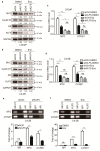KLF5 Is Crucial for Androgen-AR Signaling to Transactivate Genes and Promote Cell Proliferation in Prostate Cancer Cells
- PMID: 32245249
- PMCID: PMC7140031
- DOI: 10.3390/cancers12030748
KLF5 Is Crucial for Androgen-AR Signaling to Transactivate Genes and Promote Cell Proliferation in Prostate Cancer Cells
Abstract
Androgen/androgen receptor (AR) signaling drives both the normal prostate development and prostatic carcinogenesis, and patients with advanced prostate cancer often develop resistance to androgen deprivation therapy. The transcription factor Krüppel-like factor 5 (KLF5) also regulates both normal and cancerous development of the prostate. In this study, we tested whether and how KLF5 plays a role in the function of AR signaling in prostate cancer cells. We found that KLF5 is upregulated by androgen depending on AR in LNCaP and C4-2B cells. Silencing KLF5, in turn, reduced AR transcriptional activity and inhibited androgen-induced cell proliferation and tumor growth in vitro and in vivo. Mechanistically, KLF5 occupied the promoter of AR, and silencing KLF5 repressed AR transcription. In addition, KLF5 and AR physically interacted with each other to regulate the expression of multiple genes (e.g., MYC, CCND1 and PSA) to promote cell proliferation. These findings indicate that, while transcriptionally upregulated by AR signaling, KLF5 also regulates the expression and transcriptional activity of AR in androgen-sensitive prostate cancer cells. The KLF5-AR interaction could provide a therapeutic opportunity for the treatment of prostate cancer.
Keywords: KLF5; androgen receptor; cell proliferation; prostate cancer; tumorigenesis.
Conflict of interest statement
All authors declare no conflict of interest to this work.
Figures






Similar articles
-
Opposing transcriptional programs of KLF5 and AR emerge during therapy for advanced prostate cancer.Nat Commun. 2021 Nov 4;12(1):6377. doi: 10.1038/s41467-021-26612-1. Nat Commun. 2021. PMID: 34737261 Free PMC article.
-
Dissociation between androgen responsiveness for malignant growth vs. expression of prostate specific differentiation markers PSA, hK2, and PSMA in human prostate cancer models.Prostate. 2003 Mar 1;54(4):249-57. doi: 10.1002/pros.10199. Prostate. 2003. PMID: 12539223
-
KLF5 enhances SREBP-1 action in androgen-dependent induction of fatty acid synthase in prostate cancer cells.Biochem J. 2009 Jan 1;417(1):313-22. doi: 10.1042/BJ20080762. Biochem J. 2009. PMID: 18774944
-
Resolving the Coffey Paradox: what does the androgen receptor do in normal vs. malignant prostate epithelial cells?Am J Clin Exp Urol. 2018 Apr 1;6(2):55-61. eCollection 2018. Am J Clin Exp Urol. 2018. PMID: 29666833 Free PMC article. Review.
-
Suppressive Role of Androgen/Androgen Receptor Signaling via Chemokines on Prostate Cancer Cells.J Clin Med. 2019 Mar 13;8(3):354. doi: 10.3390/jcm8030354. J Clin Med. 2019. PMID: 30871130 Free PMC article. Review.
Cited by
-
Opposing transcriptional programs of KLF5 and AR emerge during therapy for advanced prostate cancer.Nat Commun. 2021 Nov 4;12(1):6377. doi: 10.1038/s41467-021-26612-1. Nat Commun. 2021. PMID: 34737261 Free PMC article.
-
Nitazoxanide inhibits acetylated KLF5-induced bone metastasis by modulating KLF5 function in prostate cancer.BMC Med. 2023 Feb 21;21(1):68. doi: 10.1186/s12916-023-02763-4. BMC Med. 2023. PMID: 36810084 Free PMC article.
-
Single-Nucleus RNA Sequencing and Spatial Transcriptomics for Squamous Cell Carcinoma Arising From Ovarian Mature Teratoma.Cancer Sci. 2025 May;116(5):1339-1351. doi: 10.1111/cas.70022. Epub 2025 Feb 13. Cancer Sci. 2025. PMID: 39948701 Free PMC article.
-
Portulaca oleracea Extract Ameliorates Testosterone Propionate-Induced Benign Prostatic Hyperplasia in Male Sprague-Dawley Rats.Vet Med Sci. 2025 Jan;11(1):e70184. doi: 10.1002/vms3.70184. Vet Med Sci. 2025. PMID: 39739367 Free PMC article.
-
Post-Translational Modifications That Drive Prostate Cancer Progression.Biomolecules. 2021 Feb 9;11(2):247. doi: 10.3390/biom11020247. Biomolecules. 2021. PMID: 33572160 Free PMC article. Review.
References
-
- Reid A.H., Attard G., Ambroisine L., Fisher G., Kovacs G., Brewer D., Clark J., Flohr P., Edwards S., Berney D.M., et al. Molecular characterisation of ERG, ETV1 and PTEN gene loci identifies patients at low and high risk of death from prostate cancer. Br. J. Cancer. 2010;102:678–684. doi: 10.1038/sj.bjc.6605554. - DOI - PMC - PubMed
-
- Tu J.J., Rohan S., Kao J., Kitabayashi N., Mathew S., Chen Y.T. Gene fusions between TMPRSS2 and ETS family genes in prostate cancer: Frequency and transcript variant analysis by RT-PCR and FISH on paraffin-embedded tissues. Mod. Pathol. 2007;20:921–928. doi: 10.1038/modpathol.3800903. - DOI - PubMed
LinkOut - more resources
Full Text Sources
Research Materials
Miscellaneous

